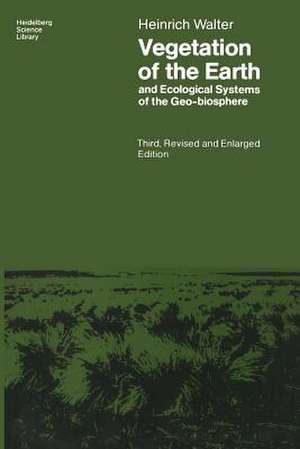Vegetation of the Earth and Ecological Systems of the Geo-biosphere: Heidelberg Science Library
Autor Heinrich Walter Traducere de Owen Muiseen Limba Engleză Paperback – iul 1985
Din seria Heidelberg Science Library
- 18%
 Preț: 877.25 lei
Preț: 877.25 lei - 20%
 Preț: 324.31 lei
Preț: 324.31 lei - 15%
 Preț: 529.28 lei
Preț: 529.28 lei -
 Preț: 381.43 lei
Preț: 381.43 lei -
 Preț: 378.92 lei
Preț: 378.92 lei -
 Preț: 379.48 lei
Preț: 379.48 lei - 5%
 Preț: 365.82 lei
Preț: 365.82 lei - 20%
 Preț: 440.78 lei
Preț: 440.78 lei - 15%
 Preț: 635.80 lei
Preț: 635.80 lei - 5%
 Preț: 361.23 lei
Preț: 361.23 lei - 20%
 Preț: 322.68 lei
Preț: 322.68 lei -
 Preț: 384.86 lei
Preț: 384.86 lei - 5%
 Preț: 359.78 lei
Preț: 359.78 lei - 5%
 Preț: 361.23 lei
Preț: 361.23 lei -
 Preț: 383.33 lei
Preț: 383.33 lei -
 Preț: 380.25 lei
Preț: 380.25 lei -
 Preț: 384.48 lei
Preț: 384.48 lei -
 Preț: 385.62 lei
Preț: 385.62 lei -
 Preț: 385.08 lei
Preț: 385.08 lei - 15%
 Preț: 632.37 lei
Preț: 632.37 lei -
 Preț: 389.70 lei
Preț: 389.70 lei -
 Preț: 379.09 lei
Preț: 379.09 lei -
 Preț: 381.81 lei
Preț: 381.81 lei
Preț: 580.46 lei
Preț vechi: 682.90 lei
-15% Nou
Puncte Express: 871
Preț estimativ în valută:
111.08€ • 120.62$ • 93.31£
111.08€ • 120.62$ • 93.31£
Carte tipărită la comandă
Livrare economică 22 aprilie-06 mai
Preluare comenzi: 021 569.72.76
Specificații
ISBN-13: 9783540137481
ISBN-10: 3540137483
Pagini: 340
Ilustrații: XVI, 318 p.
Dimensiuni: 155 x 235 x 18 mm
Greutate: 0.48 kg
Ediția:3rd rev. and enlarged ed.
Editura: Springer Berlin, Heidelberg
Colecția Springer
Seria Heidelberg Science Library
Locul publicării:Berlin, Heidelberg, Germany
ISBN-10: 3540137483
Pagini: 340
Ilustrații: XVI, 318 p.
Dimensiuni: 155 x 235 x 18 mm
Greutate: 0.48 kg
Ediția:3rd rev. and enlarged ed.
Editura: Springer Berlin, Heidelberg
Colecția Springer
Seria Heidelberg Science Library
Locul publicării:Berlin, Heidelberg, Germany
Public țintă
Professional/practitionerCuprins
Introduction: The Classification of Ecological Systems.- 1. The Aims of Ecology.- 2. Classification of the Geo-biosphere into Zonobiomes.- 3. Zonoecotones.- 4. Orobiomes.- 5. Pedobiomes.- 6. Biomes.- 7. The Nature and Structure of Ecosystems.- 8. Special Material Cycles in Terrestrial Ecosystems and the Role Played by Fire.- 9. Smaller Units of Ecological Systems: Biogeocenes and Synusiae.- 10. Diagrammatic Representation of the Hierarchy of Ecological Units..- General Section.- 1. The Historical Factor.- 2. Climate and Its Representation (Climate Diagrams, Homoclimes, and Climate-Diagram Maps).- 3. Environment and Competition.- 4. Ecotypes and the Law of Change of Biotope and Relative Constancy of Habitat. Extrazonal Vegetation.- 5. Poikilohydric and Homeohydric Plants and Halophytes.- Special Section.- I Zonobiome of the Equatorial Humid Diurnal Climate with Evergreen Tropical Rain Forest.- Zonoecotone I/II — Semievergreen Forest.- II Zonobiome of the Humido-Arid Tropical Summer-Rain Region with Deciduous Forests.- Zonoecotone II/III — Climatic Savannas.- III Zonobiome of the Subtropical Arido Climate with Deserts.- Zonoecotone III/IV — Semidesert.- IV Zonobiome of the Winter-Rain Region with an Arid-Humid Climate and Sclerophyllic Woodlands.- V Zonobiome of the Warm-Temperate Humid Climate.- VI Zonobiome of the Temperate-Nemoral Climate.- Zonoecotone VI/VII — Forest-Steppe.- VII Zonobiome of the Arid-Temperature Climate.- Zonoecotone VIII/XI — Boreonemoral Zone.- VIII Zonobiome of the Cold-Temperate Boreal Climate.- Zonoecotone VII/IX — Forest Tundra.- IX Zonobiome of the Arctic Tundra Climate.- Summary.- Phytomass and Primary Production of the Various Vegetational Zones and of the Entire Biosphere.- Conclusion from an Ecological Point of View.- 1. ThePopulation Explosion in the Developing Countries.- 2. Excessive Technological Developments in the Industrial Countries.- References.










